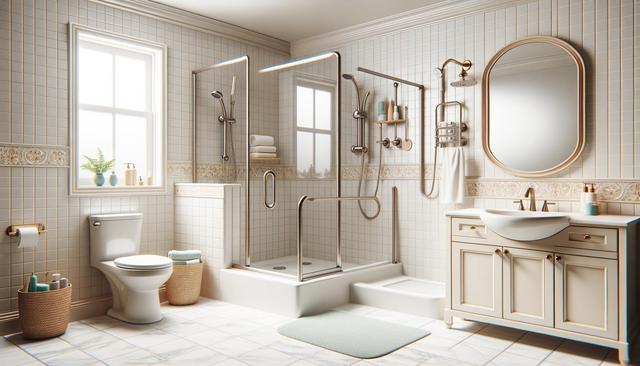Understanding the Need for Senior Bathroom Renovations
As individuals age, their mobility and physical needs change, making it essential to adapt living spaces accordingly. Bathrooms, in particular, can pose significant safety risks due to wet surfaces, tight spaces, and hard fixtures. Senior Bathroom Renovations are not just about aesthetics—they are about functionality, safety, and dignity. A well-designed renovation can help prevent falls, support independence, and promote a better quality of life. For many, this process is part of a larger effort known as Aging in Place Bathroom Remodels, which allow seniors to remain in their homes longer and more safely.
Many seniors face challenges such as arthritis, vision impairments, or balance issues, which make traditional bathroom layouts unsuitable. Renovating with these factors in mind ensures that the space is easier to navigate and use. Updating a bathroom to meet these needs can be a proactive step in home planning for older adults and their families.
Designing with Accessibility in Mind
Accessible Bathroom Remodeling focuses on creating a space that accommodates a wide range of physical abilities. These remodels often include features that make everyday tasks easier and safer for seniors. The key is to reduce the risk of accidents while maintaining an environment that feels welcoming and familiar.
Common accessibility features include:
- Walk-in or roll-in showers with non-slip flooring
- Grab bars near toilets, bathtubs, and showers
- Comfort-height toilets and vanities
- Handheld showerheads and lever-style faucets
- Widened doorways for wheelchair access
These additions can significantly improve functionality without compromising style. It’s also important to consider lighting, as well-lit areas reduce the risk of trips and falls. Motion-sensor lights or night lights are especially helpful for nighttime use.
Choosing Senior Friendly Bathroom Designs
Senior Friendly Bathroom Designs aim to blend safety with comfort and visual appeal. These designs prioritize ease of use while maintaining a homely, non-institutional look. Soft color palettes, clear visual contrast between surfaces, and clutter-free layouts are often used to support seniors with declining eyesight or cognitive function.
When selecting materials and fixtures, prioritize durability and low maintenance. For instance, anti-slip tiles, mold-resistant surfaces, and easy-to-clean finishes are practical choices. Additionally, incorporating seating areas in the shower or near the vanity can provide extra support and comfort.
Thoughtful design also includes storage solutions that are accessible without bending or reaching too far. Pull-out shelves, open shelving, and wall-mounted storage units can keep essentials within easy reach while minimizing clutter.
Planning Aging in Place Bathroom Remodels
Aging in Place Bathroom Remodels are a strategic way to prepare a home for long-term use. These remodels focus not only on immediate needs but also on anticipating future changes in mobility and health. Planning ahead allows homeowners to spread out costs and avoid rushed renovations due to sudden life events.
Key elements to consider during planning include:
- Future-proof layouts that can accommodate mobility aids
- Universal design principles that serve all ages and abilities
- Non-slip flooring throughout the bathroom
- Plumbing configurations that allow for later upgrades, such as walk-in tubs
Consulting with professionals who specialize in senior-friendly renovations can ensure that the design meets current and future needs. Occupational therapists can also provide valuable insights into what features would be most beneficial based on individual conditions.
Working with Professionals for Accessible Bathroom Remodeling
Hiring experienced contractors or designers who understand the nuances of Accessible Bathroom Remodeling is key to a successful project. Professionals can assess the existing space, recommend practical solutions, and execute the remodel with precision and safety in mind. They are also familiar with building codes and can ensure that installations like grab bars and ramps are compliant and effective.
Before starting, it’s advisable to:
- Set a realistic budget with room for unexpected costs
- Review portfolios and references of remodelers with relevant experience
- Discuss timelines and the impact of the project on daily life
- Request a detailed plan that outlines each phase of the renovation
Involving the senior who will use the bathroom in the planning process can lead to better outcomes. Their feedback ensures that the final design aligns with their preferences and daily routines, increasing their comfort and satisfaction with the space.
Conclusion: Empowering Independence Through Design
Bathroom Remodeling for Seniors is a meaningful way to enhance safety, independence, and well-being. By investing in Senior Bathroom Renovations and incorporating principles of Accessible Bathroom Remodeling, families can create spaces that support aging with dignity. Whether it’s a small upgrade or a complete overhaul, thoughtful design can make a significant difference in everyday life. With Senior Friendly Bathroom Designs and Aging in Place Bathroom Remodels, seniors can continue enjoying their homes with greater comfort and confidence.






